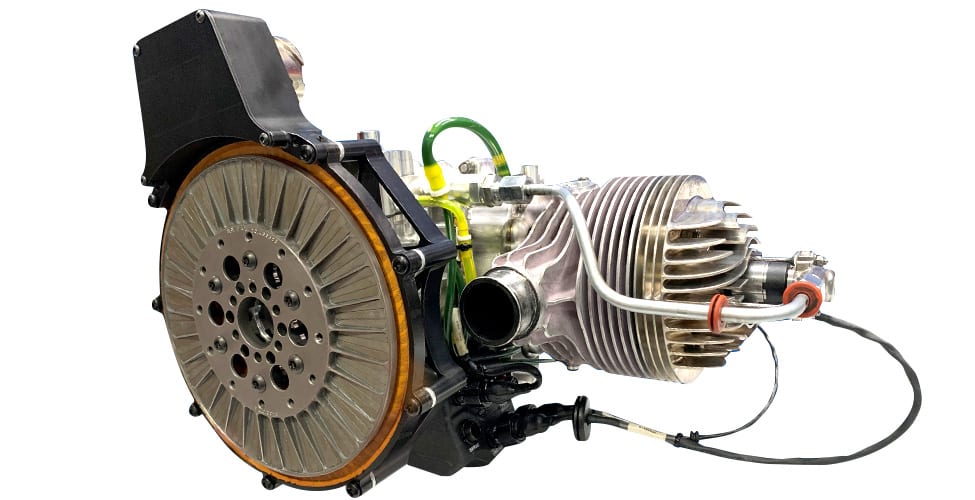
The GenSet is a patented LaunchPoint design generator that adjusts to the different power requirements needed by the vehicle during flight by adjusting the generator’s voltage to match the battery’s voltage. (LaunchPoint)
Aircraft are at a disadvantage when it comes to battery-powered solutions because current battery technology puts significant strain on an aircraft’s payload capacity. LaunchPoint Electric Propulsion Solutions, Inc., a company focused entirely on electric propulsion for aircraft, is looking to hybrid systems as a solution to this problem, Michael Ricci, LaunchPoint CTO, told Aviation Today.
LaunchPoint debuted a new hybrid electric generator system, the HPS055 GenSet, that will provide drones with efficient power and extended ranges, the company said in a June 25 press release.
“They’ll [batteries] work for like the short urban air mobility missions where you’re going to fly 20 minutes into a city, that’s fine, but if you really want to do higher endurance missions with an aircraft anytime in the reasonable business future, you’re going to need a hybrid solution where you can use the energy density of liquid chemical fuels and convert that to electricity so that you get the nice advantage of electric motors and propellers,” Ricci said.
The HPS055 GenSet offers 5.5 kW of power, a battery management system, in-flight self-charging capabilities, and a liquid-fuel-powered generator. The big draw of the system is its ability to extend the endurance of the vehicles. Ricci said that while performance will vary from drone to drone this system could extend the endurance five times longer than previously possible.
“The GenSet can enable 4x to 5x longer endurance for an electric multirotor with the same payload when the electric multirotor becomes a hybrid-electric system with our GenSet,” Ricci said.
The battery and the GenSet, which is the liquid fuel energy conversion device, work together to power the aircraft with the battery being used for power boosts and the GenSet recharging the battery while in flight, Ricci said.
“That battery provides you peak power so if you need to take off quickly if you need to climb quickly, or maneuver, the battery provides that peak power, and then the GenSet will recharge that when you’re kind of cruising along not using the full GenSet power,” Ricci said.
The system can also run solely on the battery for short periods of time.
“If you have a place you need to fly where you don’t want the engine noise you can actually shut off the engine and run on just the battery,” Ricci said. “The battery drains fairly quickly, but you can shut off the engine in flight and run just the battery for a little while and then restart the engine and recharge the batteries while you’re flying around under the engine-generated electricity.”
This also works as a safety feature allowing the aircraft to have energy reserves to land in the event that the aircraft ran out of fuel.
“This is one of the safety things that the hybrid system adds is if you run out of gas you still have that battery pack which has some energy in it and that gives you a couple of minutes of flight time to land yourself safely if you do run out of gas,” Ricci said. “So, it’s also a safety feature as well as this peak power for accelerating and maneuvering.”
The GenSet is a patented LaunchPoint design generator that adjusts to the different power requirements needed by the vehicle during flight by adjusting the generator’s voltage to match the battery’s voltage, Ricci said.
“We have a very sophisticated control algorithm, we call the power management unit, and that power management unit manages the engine and the generator to make this power flow happen seamlessly and transparently to the user,” Ricci said. “So, the user flies it as if it’s a battery-powered vehicle and meanwhile our system understands what the user is doing and manages the throttle and controls the generator to provide clean smooth well-regulated power to the electric motors.”
While the 5.5kW system is designed for drones, Ricci says the system is scalable for use in larger vehicles like electric air taxis.
“It’s absolutely scalable,” Ricci said. “We have a 40-kilowatt system that is basically available now…and we’re working with other people on components up to 250 kilowatts,” he added. “We don’t have the whole 250-kilowatt system but working with other manufacturers on some of the subsystems that they’re going to put into a 250-kilowatt hybrid system so it’s absolutely scalable.”
Ricci said the system could also be adjusted to accommodate biofuels like sustainable aviation fuels with a different engine. LaunchPoint has a heavy fuel engine manufacturer that they are partnering with for a heavy fuel variant system.
LaunchPoint has worked with the Army Research Laboratory on this system through a small business innovation research (SBIR) contract, Ricci said. They have also worked with NASA, the Navy, and the Air Force on the development of this technology.
Ricci said that LaunchPoint will update this system with improvements in the next six to nine months.
“There’ll be a version two in six to nine months that will be better, but I don’t recommend people wait for that,” Ricci said. “What I recommend people do is get the one right now because hybrid systems are a little more complicated, they’re not terribly difficult but there’s just more going on than a battery-powered, so what we’re recommending is people get the system now, learn how to use it, learn how to fly it, and then you know there’ll be a better system out in six to nine months and they’ll just get better performance for their vehicle.”